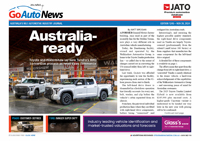Make / Model Search
News - HondaHonda closes UK plantGoing down: Honda has pointed to its move to electrification of its range as the reason for the closure of its Swindon factory in the United Kingdom. Civic Type R to roll on, despite shock decision to close Honda’s UK factory20 Feb 2019 HONDA Australia has promised the Civic Type R hot hatch will continue on in Australia after 2021 when the current source – Honda of the UK Manufacturing in Swindon, England – is scheduled to close its doors after three decades.
The Civic Type R is the only current model made for Australia at the British plant that has been producing about 150,000 cars a year on production lines designed for 250,000.
Announced by the company yesterday along with the planned closure of a 40,000-car-a-year plant in Turkey, the Swindon closure will cost 3500 jobs at Honda and many more at parts suppliers.
But Honda Australia director Stephen Collins said it will be business as usual at the Australia operation.
“We are aware of the changes announced yesterday regarding Honda’s global business activities,” he said.
“Honda Australia currently receives the Civic Type R from the Swindon manufacturing plant in the UK. There are no changes that impact Honda Australia or our customers – we will continue to take the Civic Type R from Europe throughout the current model’s production lifecycle and we intend for the next generation model to also have a home in Australia.
“We will also continue to support Honda’s management team as they restructure our global automobile production operations to ensure Honda remains strong and can continue offering products that fulfil the needs of our customers around the world.”
Honda has indicated that vehicles for the European market will be supplied from Japan from 2021 after Japan and the European Union recently agreed on a zero tariff export arrangement.
This might mean that the next Civic Type R could come from a Japanese factory, which would suit Honda Australia once Swindon supplies dry up in two or three years. Australia and Japan have a free-trade agreement, and supply lines are shorter.
Although unions and many politicians in Britain blamed the Brexit debacle for the first closure of a major Honda car factory, the company blamed its impending switch to electrified vehicles.
Honda Motor Europe president Katsushi Inoue said: “In light of the unprecedented changes that are affecting our industry, it is vital that we accelerate our electrification strategy and restructure our global operations accordingly.
“As a result, we have had to take this difficult decision to consult our workforce on how we might prepare our manufacturing network for the future. This has not been taken lightly and we deeply regret how unsettling today’s announcement will be for our people.”
HUM director Jason Smith added: “We understand the impact this proposal will have on our associates (employees), wider supplier base and the local community. We are committed to supporting associates to help them through this difficult time.”
Nissan last month announced that it had cancelled plans to build the X-Trail mid-sized SUV at its Sunderland factory, in northern England, due to Brexit and the potential for a tariff barrier with the EU market.
Land Rover has already switched Discovery production to a new factory in the Czech Republic, and Ford of Europe has warned that a “no-deal” Brexit would have catastrophic effects on British manufacturing.
For Honda, the rapid decline of diesel models in Europe has also affected the viability of the Swindon plant that was one of the few plants in the Honda empire to build such cars alongside its petrol burners.
As we saw with the demise of Toyota’s Australian factory at Altona in 2017, Japanese manufacturers are extremely reluctant to take a backward step on global operations.
The closure of Swindon and the Turkish operation would be seen within the company as a defeat, with loss of face, after decades of successful expansion.
However, in typical Japanese fashion, the transfer of production to other plants no doubt will be well planned and orderly, and Honda’s Australian customers will barely notice.
The Swindon plant is built on a former World War 2 airfield, with engine manufacturing starting there in 1989. Full car production began in 1992, starting with the Civic and then extending to Accord, Jazz and CR-V.
Among models shipped to Australia were a five-door Civic liftback and a CR-V diesel – both discontinued in this market.  Read more |
Click to shareHonda articlesResearch Honda Motor industry news |












Facebook Twitter Instagram